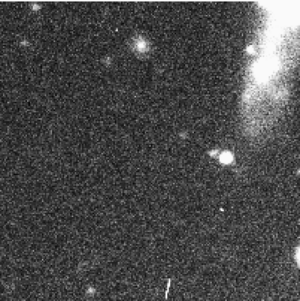Prospero (moon) facts for kids
|
Discovery image of Prospero.
|
|
| Discovery | |
|---|---|
| Discovered by |
|
| Discovery date | 18 July 1999 |
| Designations | |
| Adjectives | Prosperonian, Prosperian |
| Orbital characteristics | |
|
Mean orbit radius
|
16,256,000 km |
| Eccentricity | 0.4448 |
| 1978.29 d | |
| Inclination | 152° (to the ecliptic) |
| Satellite of | Uranus |
| Physical characteristics | |
|
Mean radius
|
25 km (estimate) |
| ~8000 km² (estimate) | |
| Volume | ~65,000 km³ (estimate) |
| Mass | ~8.5×1016 kg (estimate) |
|
Mean density
|
~1.3 g/cm³ (assumed) |
| ~0.0063 m/s² (estimate) | |
| ~0.021 km/s (estimate) | |
| ? | |
| ? | |
| Albedo | 0.04 (assumed) |
| Temperature | ~65 K (estimate) |
Prospero is a small moon that orbits the planet Uranus. It's special because it moves in a retrograde way, meaning it orbits Uranus in the opposite direction compared to most other moons. Prospero also isn't perfectly round like a ball. Scientists found this moon on 1999-07-18. It was discovered by Matthew Holman and his team.
Prospero was first called S/1999 U 3. Later, it was officially named Uranus XVIII. Its name comes from the sorcerer Prospero in William Shakespeare's famous play, The Tempest.
Prospero's Orbit and Appearance
Scientists think Prospero might have formed from the same original space rock as two other moons, Sycorax and Setebos. This is because their orbits around Uranus are quite similar.
However, the colors of these moons are different. Prospero looks grey when we see it, just like Setebos. But Sycorax is a light red color, which is different from Prospero.
Related pages
Images for kids
See also
 In Spanish: Próspero (satélite) para niños
In Spanish: Próspero (satélite) para niños



